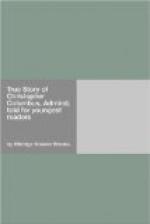Columbus was a dreamer; he saw such wonderful visions of what was to be, that people, as we know, tapped their foreheads and called him “the crazy Genoese.” But not even the wildest fancies nor the most wonderful dreams of Columbus came anywhere near to what he would really have seen if—he could have visited the Exposition at Chicago, in the great White City by the lake—a “show city” specially built for the World’s Fair of 1893, given in his honor and as a monument to his memory.
Why, he would say, the Cathay that I spent my life trying to find was but a hovel alongside this! What would he have seen? A city stretching a mile and a half in length, and more than half a mile in breadth; a space covering over five hundred acres of ground, and containing seventeen magnificent buildings, into any one of which could have been put the palaces of all the kings and queens of Europe known to Columbus’s day. And in these buildings he would have seen gathered together, all the marvelous and all the useful things, all the beautiful and all the delightful things that the world can make to-day, arranged and displayed for all the world to see. He would have stood amazed in that wonderful city of glass and iron, that surpassingly beautiful city, all of purest white, that had been built some eight miles from the center of big and busy Chicago, looking out upon the blue waters of mighty Lake Michigan. It was a city that I wish all the boys and girls of America—especially all who read this story of the man in whose honor it was built, might have visited. For as they saw all its wonderful sights, studied its marvelous exhibits, and enjoyed its beautiful belongings, they would have been ready to say how proud, and glad, and happy they were to think that they were American girls and boys, living in this wonderful nineteenth century that has been more crowded with marvels, and mysteries, and triumphs than any one of the Arabian Nights ever contained.
But, whether you saw the Columbian Exhibition or not, you can say that. And then stop and think what a parrot did. That is one of the most singular things in all this wonder story you are reading. Do you not remember how, when Columbus was slowly feeling his way westward, Captain Alonso Pinzon saw some parrots flying southward, and believing from this that the land they sought was off in that direction, he induced Columbus to change his course from the west to the south? If Columbus had not changed his course and followed the parrots, the Santa Maria, with the Pinta and the Nina, would have sailed on until they had entered the harbor of Savannah or Charleston, or perhaps the broad waters of Chesapeake Bay. Then the United States of to-day would have been discovered and settled by Spaniards, and the whole history of the land would have been quite different from what it has been. Spanish blood has peopled, but not uplifted, the countries of South America and the Spanish Main. English blood, which, following after—because




